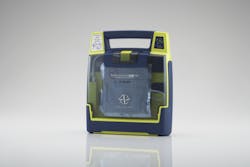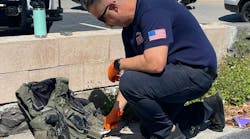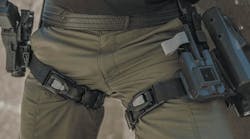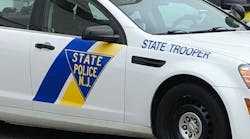Ten fire and police departments around the country are gearing up to implement much-needed AEDs that they won through the Cardiac Science online contest held in December in partnership with Firehouse.com and Officer.com.
Many of those selected were able to share the inspiring stories of how these AEDs will impact their systems – and how they’re further working to overcome financial challenges to better serve their communities.
The agencies will each receive one Cardiac Science Powerheart AED G3, which includes:
* Rescue Ready® technology with daily self-tests
* Intellisense® lithium battery with 4-year guarantee
* 7-year warranty
* Ready Kit and carry case
* Two sets of defibrillation pads
* And more
Earlton Fire District, N.Y.
“We never dreamed we’d have a chance,” said Firefighter Charlie Pike. “We’re just a small fire department in upstate New York.” He described the area as a small community with one restaurant, a campground, and very limited funds.
Pike, who is also a per diem paramedic, is in charge of the department’s AED program, which previously involved maintenance and training for just one AED. He’s delighted that they’ll now have a second.
“We have one on one of our fire engines that we purchased on a close-out sale, also from Cardiac Science,” he said.
They’ve had that one for close to five years but haven’t had enough money to buy another , he said, so when it leaves on the engine, the firehouse has been left unprotected. Pike said that has been unacceptable because the fire department is a central location for community events such as parties, as a polling place, and for a rabies vaccine clinic that draws hundreds.
“So this one is to stay in the firehouse to keep it covered for events or anyone who comes in,” Pike said.
“…Everybody in the fire department still thinks I’m kidding them… they’re all very excited and appreciative.”
City of Antelope, Ore.
The community has never before had an AED, so this will be their first, said Fire Chief Michael Carter.
“We had solicited businesses to donate, but donations are hard to get when money is short and you’re in a rural area,” he said.
He said they’re a small city department, but also respond 10-15 miles outside the town. “It’s an unofficial district because there’s nothing else out there,” he said.
Ambulance service takes 45 minutes to an hour to arrive, and helicopter rescue service takes 35-40 minutes, so having a local AED is imperative, he said. This one will be kept on a local rescue rig.
Carter said acquiring their first AED is part of a larger end-goal; getting a second AED to keep at the town’s post office because it’s centrally located and open to residents 24/7; helping to get an AED for a sister community; and developing a local EMS program.
“Everything’s got to have a start,” he said. “It will come in very handy… it’s a good first step in the right direction.”
Wausau Fire, Wis.
“I typically look at Firehouse every morning at work – the contest was something I saw on the website,” said Josh Finke of the department’s EMS division. “...We appreciate the award and it will be put to good use.”
Wausau Fire is working to get a substantial AED program up and running, Finke said. They’re trying to upgrade the AEDs they currently have on their vehicles and to increase the success of their cardiac arrest programs.
Finke said this new AED will go on their fire marshal’s vehicle, and they hope to acquire more to add to their fire inspectors’ vehicles. He said the city also now has 10 distributed in buildings around the city.
“The hope is after this we can continue to develop the program,” he said.
He explained that the department has multiple efforts going on as they seek to improve their cardiac arrest survival rates. Among other things, these include “pushing the things that work - early CPR and early AED, and free education for citizens.”
Aristas Fire, Pa.
For Aristas Fire, acquiring an AED is a very personal matter to the members.
During a fundraising breakfast in 2003, “One of our members collapsed,” said Capt. Greg Yeager. Members initiated care but were on their own without an AED until an official EMS response arrived about 15 minutes later.
“He ended up succumbing to his condition,” Yeager said, and that scenario could happen again to a resident or responder because in their small community, 65-70 percent of the residents are over 60. “Our membership pool comes from that population,” he said, so chances are increased that another member could suffer a cardiac event with the stress of responding or fundraising.
After that loss, the department initiated an AED program under the member’s name. They collected money, got a grant and bought their first AED, but it now needs replacement so this will be their second but only AED.
“We’re very excited about it. It’s going to be a key component in efforts to provide additional service to the community,” Yeager said.
The community’s need has only grown, he noted, because the closest ambulance service they had closed down two years ago. He said Aristas Fire doesn’t officially provide medical assistance, but their EMT and paramedic members go out if they hear a medical call, and provide care until ALS or BLS arrives from about eight miles away.
Their next goals include acquiring the necessary equipment and licensing to get dispatched as the local EMS first response agency, and to offer free CPR and AED training to the community.
“We want to thank Firehouse, Firehouse.com and Cardiac Science for offering this [AED] – we know it’s not a small expense,” Yeager said. “You could never put a price tag on what it can do.”
Sauratown, N.C.
Assistant Fire Chief Fred Lawson and Medical Director Darrell Nelson explained that they serve a system that’s rural, but is working to become progressive in the area of cardiac care.
“It’s a program that we started in January 2011 after the AHA update on cardio vascular care,” Nelson said. Efforts have included changing their approach on CPR to assign specific roles to each responder as they arrive and the team builds; doing all resuscitation on scene to concentrate on good, uninterrupted CPR; providing impedance threshold devices directly to responders so they don’t have to wait for ALS; and introducing therapeutic hypothermia.
“Usually those are things done by bigger agencies with more resources,” Nelson noted.
Their previous cardiac arrest survival rate before the program was 8 percent, and it has now reached 42 percent using the Utstein rate, and 30 percent overall, Nelson said. Their transport times are 30-60 minutes.
“We’re ecstatic,” he said.
The community also has a public access program in place, with AEDs placed at churches, schools, etc., but Nelson said they are studying whether this is the best way to deploy AEDs in a rural community.
They recently implemented a strategy to put 15 AEDs in the hands of volunteer first responders so they can respond directly to cardiac calls, and don’t have to go pick up an AED first. (The 15 are on loan for a year, and the department will see if it can arrange to purchase them afterward, Lawson explained.)
The new AED won through the Cardiac Science contest will go in service with a first responder.
“We believe the best place in a rural community is to put them in the hands of first responders,” Nelson said. Their study will last a total of 12 months, and they aim to then publish an analysis in a peer-reviewed journal.
Of the Cardiac Science Giveaway contest, Nelson added, “It’s great that Firehouse did that and it will add to the coverage of AEDs in our community.”
Rockville Centre Auxiliary Police, N.Y.
This will be the group’s first AED, despite efforts to get one funded for a long time. “We’re very excited,” said PFC Special Marc Delman.
“We’re hoping this will be a test case to show the county how helpful it will be,” he said.
He explained they are part of county police auxiliary but are dedicated to one village, with 15 active members (all volunteer) and five vehicles. “We’re the eyes and ears of the police force and carry everything but a handgun,” he said.
The new AED will be housed in their headquarters but will be taken out by whoever is on patrol. They hope to eventually get more units so they can keep them in each car. All the members are certified in CPR and AED, but have never had the tools to use the AED training. “There are times it would have been very helpful,” Delman said.
The village has a large bar community, he said, and their members are often first on scene. Currently all they can do is CPR, but an AED will allow them to help further until the fire department or full EMS response arrives.
“I’m just very happy that we had this opportunity to enter and win,” Delman said. “I’m hoping it’s a stepping stone to getting all of our cars outfitted and showing the county how important it is.”
Licking County, Ohio
Licking County is the second largest county in Ohio, and is a very rural area where backup is 20-30 minutes away, said Deputy Keri Hoskinson.
The do have some AEDs in cruisers now, however, “some are starting to get old and have to come out of service,” she said. This one will go in a cruiser, and the department is very excited to have it, Hoskinson said.
She added that officers have had to deploy their AEDs several times, including at one recent incident in late January.
AEDs are an issue close to home for this agency, she said, because the very first time they had to use one, was when a sergeant responded to the cardiac event of on an off-duty dispatcher. As a result, “She did survive and is still working for us today,” Hoskinson said. “…We really value the AEDs we have.”
They currently have 23 on patrol vehicles and would like to get seven more deputies covered.
The additional winning law enforcement agencies were Carbon County, Mont.; Morris County, N.J.; and the Waverly Police Dept., Tenn.



